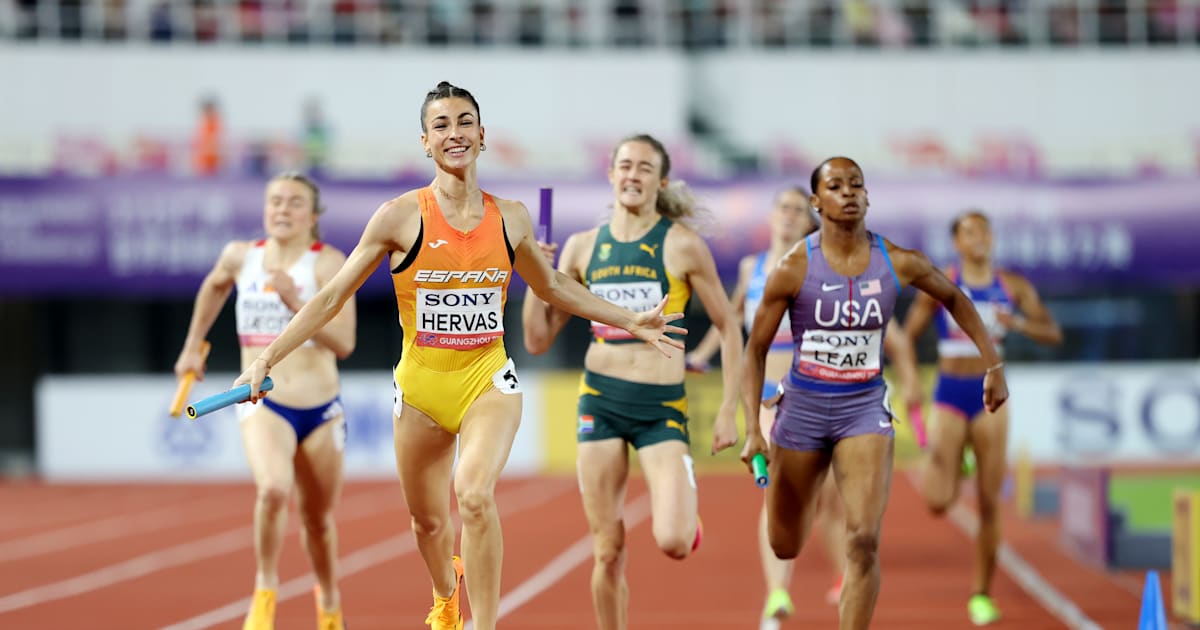## Gold Rush on the Track!
Hold onto your hats, folks, because the 4x400m relay races just went supernova in Guangzhou! It was a clash of titans, a sprint for the ages, as USA, Spain, and South Africa stormed to victory in their respective categories. We’re talking blazing legs, lightning-fast baton exchanges, and enough drama to make your pulse race.

US Still Standing, But Cracks Appear
The USA took home two gold medals from the World Athletics Relays in Guangzhou, China, but the day belonged to Spain and South Africa. The South African men’s team set a world lead in the 4x400m, while the Spanish women’s squad shocked the world by upsetting the reigning champions, the United States. This unexpected result raises questions about the USA’s dominance in the 4x400m and signals a changing landscape in the world of track and field.
Mixed 4x400m Gold Offers Some Solace
The US mixed 4x400m team secured a dominant victory, setting a new championship record of 3:09.54. This victory provided a much-needed boost for the US team after the women’s 4x400m loss. However, the mixed relay success doesn’t overshadow the significance of the women’s 4x400m defeat.
Examining the Factors Behind the Women’s Loss
The loss to Spain was a major upset, marking the first time the US women’s 4x400m team has not won gold in the World Athletics Relays since the event’s inception in 2017. Several factors may have contributed to this unexpected outcome:
- Spain’s Strong Performance: The Spanish team delivered an exceptional performance, particularly Daniela Fra on the third leg who handed off the baton to Hervas in a commanding position.
- US Relays Strategy: Some analysts suggest the US team may have opted for a conservative strategy, potentially underestimating the Spanish team’s capabilities.
- Unexpected Factors: Track and field is a sport where unexpected events can occur. It’s possible factors like fatigue, slight stumbles during handoffs, or even the weather conditions played a role in the US team’s performance.
It’s important to note that analyzing the reasons behind a single race result is complex and requires a deep understanding of the athletes’ training, tactics, and the specific circumstances of the day.
Looking Ahead: Can the US Regain its 4x400m Crown?
The loss to Spain undoubtedly serves as a wake-up call for the US team. However, the US has a rich history of success in the 4x400m relay and possesses a deep pool of talent. The team will likely use this experience as motivation to improve and reclaim its position at the top.
The team will need to identify the areas for improvement and make necessary adjustments to their training and race strategy. The upcoming World Athletics Championships will be a crucial test for the US team, providing an opportunity to prove their resilience and dominance in the 4x400m relay.
Beyond the Podium: Key Takeaways from Guangzhou
While the US might have experienced a setback, the World Athletics Relays in Guangzhou offered a glimpse into the future of track and field. Several key takeaways emerged from the competition, highlighting the evolving dynamics of the sport:
Emerging Talent and Unexpected Surprises
The Relays showcased the emergence of new talent and unexpected surprises. Spain’s stunning victory in the women’s 4x400m, South Africa’s dominant performance in the men’s 4x400m, and the strong performances of teams like Belgium and Australia demonstrate the growing depth and competitiveness within the sport.
The Importance of Team Chemistry and Strategic Relay Legs
The World Athletics Relays emphasized the crucial role of team chemistry and strategic relay legs. The success of teams like the US in the mixed relay and Spain in the women’s 4x400m highlighted the importance of strong handoffs, well-coordinated strategies, and athletes who can perform effectively under pressure.
What These Results Mean for the World Athletics Championships
The World Athletics Championships, scheduled later this year, will undoubtedly be a fiercely contested event. The Guangzhou Relays provided a valuable preview of the potential outcomes, suggesting a shift in power dynamics and a heightened level of competition. Teams will be looking to build on their recent successes, and the US will be eager to reclaim its dominance in the 4x400m relays.
Conclusion
The track blazed in Guangzhou as USA, Spain, and South Africa dominated the 4x400m relays, rewriting the history books with their remarkable victories. These weren’t just wins; they were statements of power, showcasing the culmination of years of dedicated training, strategic planning, and sheer athletic brilliance. Each nation brought a unique blend of speed, stamina, and teamwork, leaving their competitors in the dust and etching their names into the annals of athletics.
This victory isn’t just about medals; it’s about inspiration. These athletes embody the human spirit’s potential, pushing boundaries and defying limitations. Their success echoes across continents, reminding us that through unwavering dedication and the power of collective effort, anything is possible. As we move forward, we can only anticipate even more electrifying performances and groundbreaking achievements on the track. What new heights will these nations reach? Who will rise to challenge their dominance? One thing is certain: the future of athletics is in capable, determined hands, and the world is eagerly watching.
This is a new era of relay racing, an era defined by power, precision, and relentless pursuit of excellence.